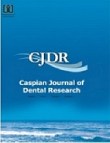Dimensional accuracy of alginate mold method on duplication of stone casts
Accurate duplication of casts is necessary to fabricate a proper prosthetic appliance with good adaptation. Alginate is an inexpensive impression material and is available in most dental offices. The aim of the present study was to evaluate the accuracy of the casts duplicated using alginate impression mold.
In this in vitro study, at first, a metallic tray and condensational silicone impression material were used to prepare 60 master impressions of a maxillary dental model. The impressions were poured using stone gypsum, and their dimensions were measured via a digital Vernier caliper with accuracy of 0.01 mm. Then, the casts were fixed on the floor of a flask filled with alginate with two folds volume of cold water recommended by the manufacturer. The resulting impressions were immediately poured, and the measurements were repeated. The data were analyzed with SPSS 26 using MANOVA and ICC index (p<0.05).
Statistical analyses showed that dimensional changes of the duplicated casts were not significant relative to the master casts (P=0.90). In addition, insignificantly, the duplicate casts were smaller than the master casts and the dimensional changes in the transverse dimension were more than those in the anteroposterior dimension.
The results indicated that alginate duplicate impressions taken using the alginate molding technique had good dimensional accuracy when they were poured immediately. Since alginate is inexpensive, this technique can be used in the dental office by saving time to decrease laboratory costs and avoid using expensive impression materials.
-
The impact of team teaching on cephalometric tracing education among dental students: A quasi-experimental study
*, Mahdis Mostajabi
Journal of Medical Education Development, Summer 2024 -
Relationship between the Estimated Dental Age and Chronological Age Using the Demirjian Method in an Iranian Population
Aisan Nouri, *, Seyed Kian Haji Seyed Javadi
Journal of Research in Dental and Maxillofacial Sciences, Autumn 2023



